
In February 2013, I went on another Siren Fleet trip, this time to Raja Ampat on board the S/Y Indo Siren. The guests were a mix of groups rather than a single group like the Komodo trip. We had 8 guests from the US, 3 from the UK, 2 from Germany, 1 from NZ and just me holding up the Aussie flag. The crew included Daeng as Captain (he'd also captained the S/Y Pa Siren on the Komodo Trip) and Nicole who had been one of the divemasters on the Komodo trip. The rest of the crew were all new, but they soon became friends.
Here's an overveiw map showing where we were in relation to Australia, Indonesia and PNG. Click on the map for a larger version.

Here's a more detailed map showing where we sailed and the location of the dive sites.
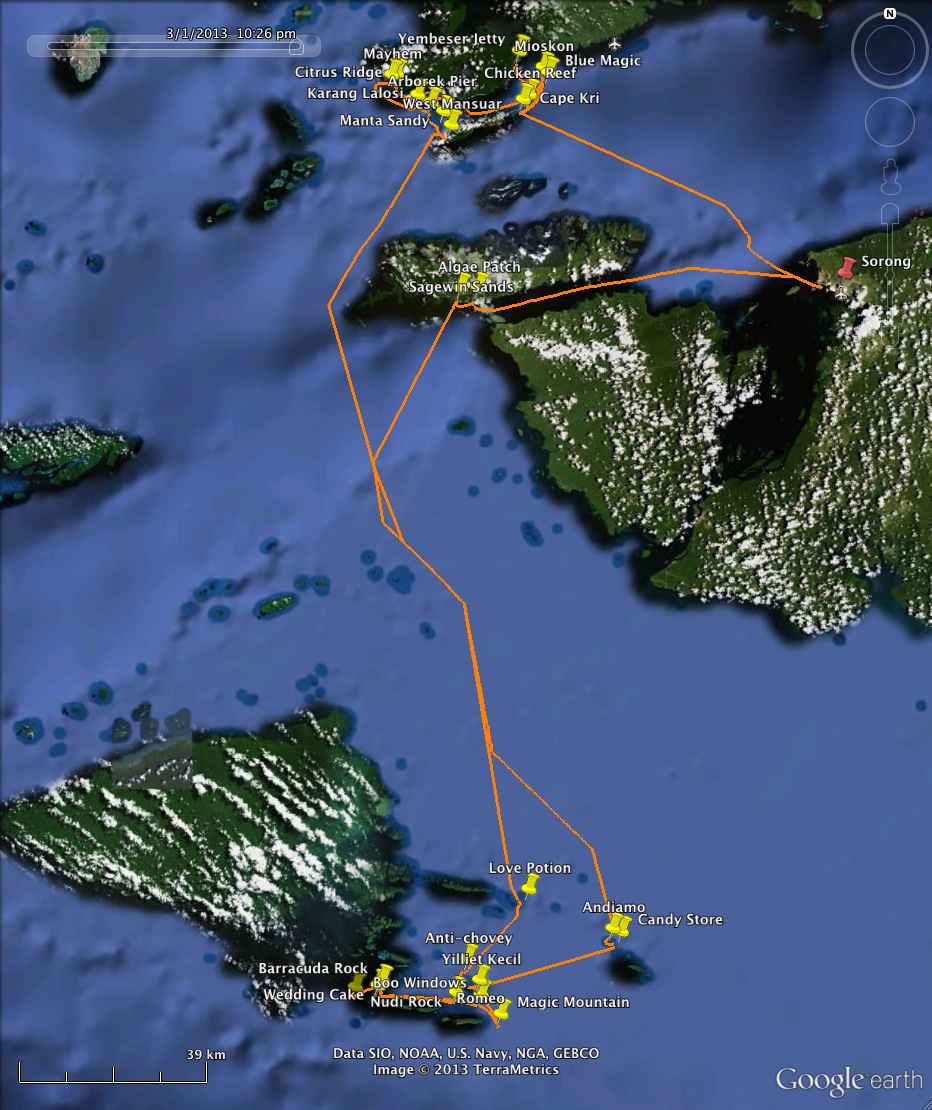
We sailed out of Sorong, West Papua at around 9:50pm heading to Batanta Island some 50 kilometres to the west. We arrived at around 6am.
The first dive of the trip was at a site called Algae Patch on the south coast of Batanta Island. This was a sandy slope with coral and rock outcrops. While it wasn't a coral reef as such, there was still plenty of interesting things to see, including a couple of cuttlefish. There was even a nautilus shell on the bottom, suggesting there may have been nautilus in the area. Dive details
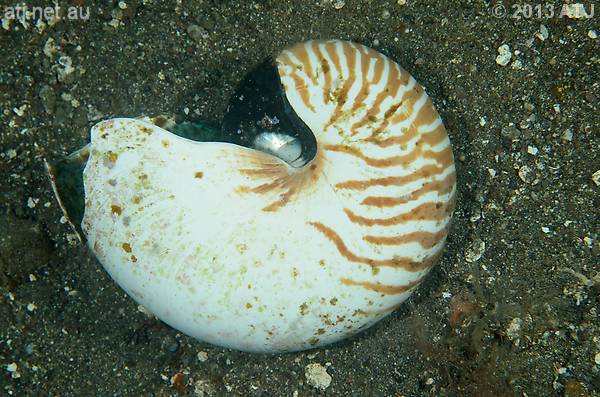
Nautilus shell seen at Algae Patch.
The second dive was also at Algae Patch. We saw more cuttlefish, and many nudibranchs. Dive details
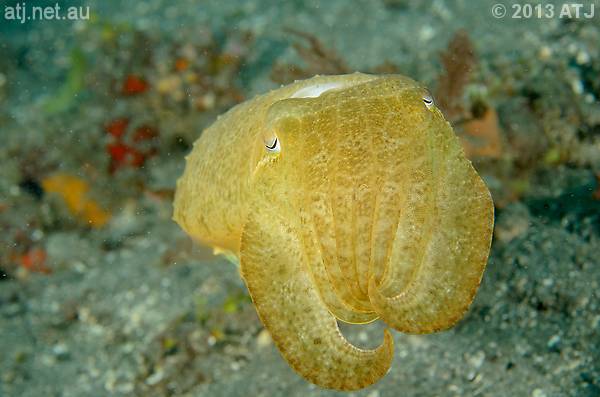
Cuttlefish, Speia sp. at Algae Patch.
After lunch we sailed around 4 kilometres to the west for the afternoon dive at a site called Sagewin Sands. This was a muck dive and we saw a lot of nudibranchs, some more cuttlefish and even a waspfish. Dive details

Waspfish, Ablabys sp.
Shortly after the dive at Sagewin Sands we started our long journey to the Ceram Sea near Misool Island. The trip was over 150 kilometres and took us nearly 12 hours. We arrived at around 5:30am on Day 3.
The first dive of the day was at a site called Andiamo. This was an absolutely brilliant dive. The water was clear and warm and our guide, Ongko, showed us a number of Denise's pygmy seahorses. I had never seen this species before. They are smaller than the regular Hippocampus bargibanti pygmy seahorse which makes them much more difficult to photograph. Dive details
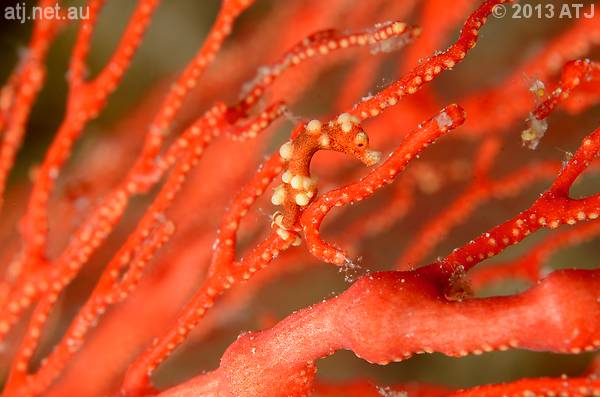
Red form of Denise's pygmy seahorse, Hippocampus denise.
The site for the second dive of the day was called Candy Store and was about a kilometre south-east of Andiamo. On this dive we saw a few longnose hawkfish as well as a lot of other organisms. Dive details
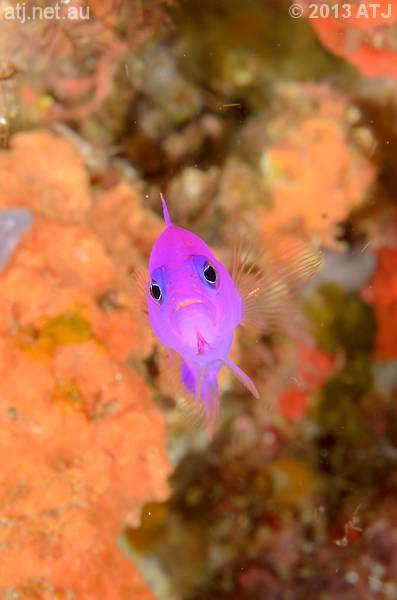
Magenta dottyback, Pictichromis porphyrea.
After lunch we sailed 30 kilometres south west for dive 3 which was at Yilliet Kecil. The first thing we notice on entering the water were all the pelagic fish swimming around, specifically chevron barracuda and fusiliers. We saw more longnose hawkfish on this dive as well as some pygmy seahorses. Dive details
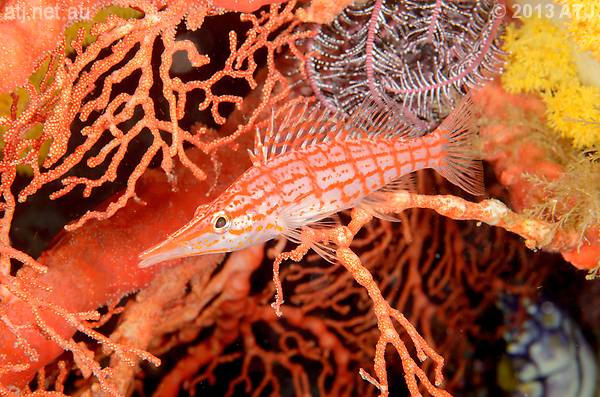
Longnose hawkfish, Oxycirrhites typus.
The final dive of the day was a night dive at a site called Romeo. I think I would have really enjoyed this dive if my mask had not been leaking. Unfortunately, the leak made it frustrating and difficult to use my camera. Despite the frustration, we did see some cool things including more pygmy seahorses, some commensal crabs and an epaulette shark. Dive details

Commensal crab, Lissocarcinus sp., on a sea cucumber.
We stayed the night at that location.
Early on day 4 we sailed a little over 10 kilometres for our next dive location.
Dives 1 and 2 for the day were at a site called Magic Mountain. As the name suggests it was a large sea mount. We covered quite a lot of ground on both dives. On the first dive I saw 4 different species of anemone fish and towards the end of the dive we saw 3 juvenile white-tip reef sharks swimming around a coral head. They'd then rest under the coral head. Dive details
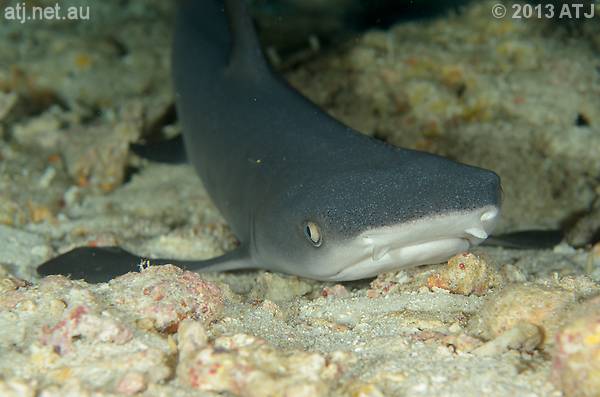
Juvenile white-tipped reef shark, Triaenodon obesus, resting under a coral head.
The second dive at Magic Mountain was no less interesting that the first. We covered a different area of the sea mount and saw a vast array of organisms. Dive details

Black-spotted puffer, Arothron nigropunctatus.
After luch we sailed around 7 kilometres north west for the 3rd and 4th dives at Boo Windows. This site is quite famous for the holes in the rock near the surface which form sort of windows. On the first dive Sheree found her first Hippocampus denise and then her first H. bargibanti. Dive details

Denise's pygmy seahorse, Hippocampus denise.
Our second dive at Boo Windows was a sunset dive. We hit the water while there was still some light and completed the dive in the dark. We saw a lot on this dive including a large juvenile batfish. Dive details
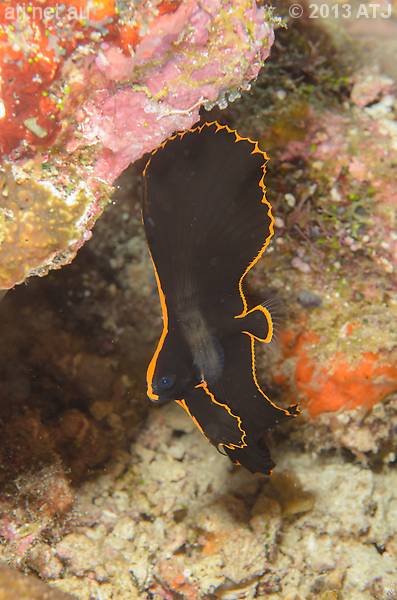
Juvenile batfish, Platax pinnatus.
After dinner we sailed 20 kilometres west in preparation for our next day's diving.
The first dive of the day was at Barracuda Rock and oddly enough, we saw a lot of barracuda there. The highlight of this dive for me was finding a Hippocampus denise on my own. While these pygmy seahorses are smaller than H. bargibanti in some conditions they can be easier to spot because they stand out more from the sea fans they inhabit. We also saw a H. bargibanti. Dive details
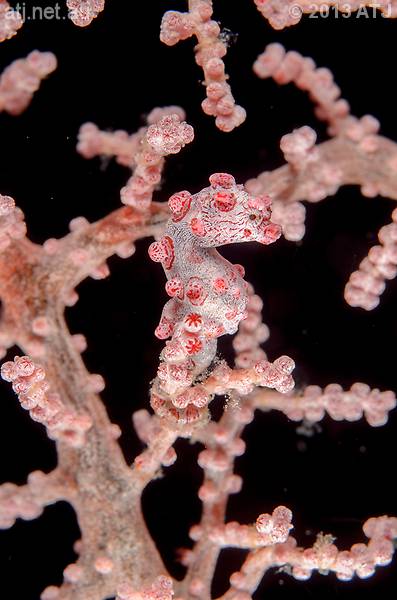
Pygmy seahorse, Hippocampus bargibanti.
After breakfast we sailed around 8 kilometres west for the next dive which was at Four Kings. Raja Ampat is Indonesian for "four kings" and so this was meant to be a quintessential site within the Raja Ampat area. It was a good dive but perhaps not truly representative of the area. For one, we didn't see any pygmy seahorses. We did see a lot of nudibranchs and a funny coincidence was seeing a saddleback puffer and then the next fish I saw was a mimic filefish (which mimics the saddleback puffer). Dive details
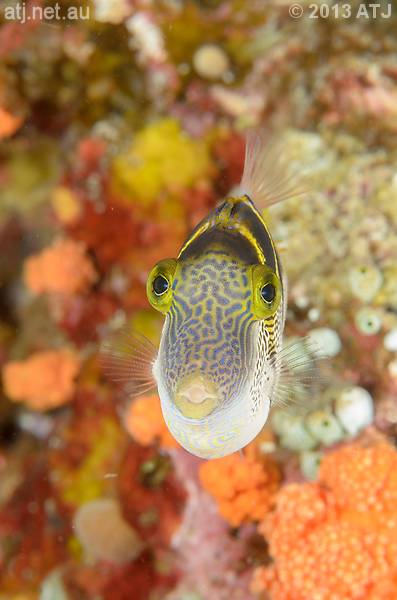
Mimic filefish, Paraluteres prionurus.
We sailed back to our previous location in preparation for the afternoon and night dives. The afternoon dive was at a site called Wedding Cake, so named because it was a sea mount with tiers like a wedding cake. We saw both regular and Denise's pygmy seahorses as well as a number of nudibranchs and a couple of peacock mantis shrimp that were out and about. Dive details

Peacock mantis shrimp, Odontodactylus scyllarus.
For the night dive we returned to Barracuda Rock. There were lots of spider crabs on this dive and we also saw a pygmy squid, a large cuttlefish and an epaulette shark. Dive details
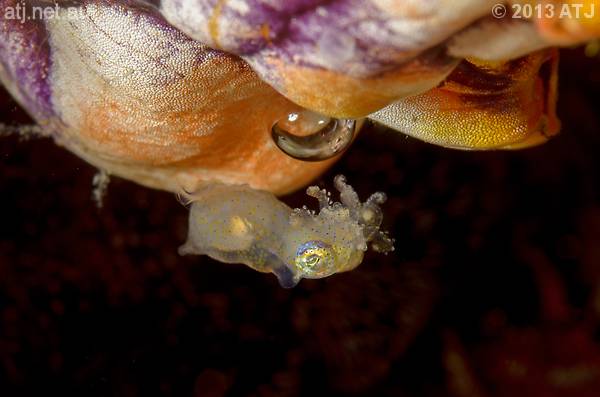
Pygmy squid.
Early on Day 6 we sailed due east for a little over 15 kilometres for our last day of diving in the southern part of Raja Ampat.
The first dive was at a site called Nudi Rock. It wasn't called this because of an abundance of nudibranchs but simply because the rock that protrudes from the water actually looks like a nudibranch with a couple of trees for the rhinophores and a circle of trees at the other end for the gills. The current on this dive was quite strong, particularly around the middle of the dive. I used quite a lot of air fighting the current. I did manage to find a Denise's pygmy seahorse which I was thrilled about. Dive details
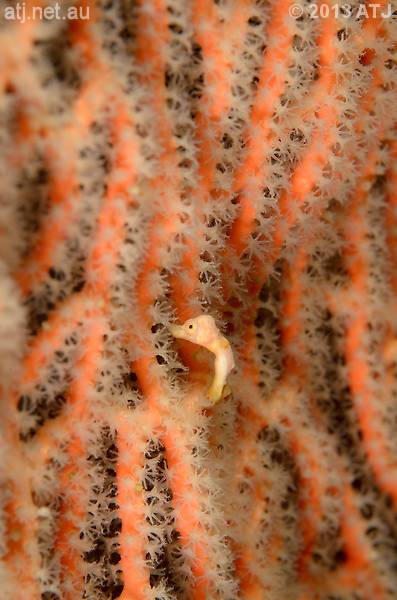
Denise's pygmy seahorse, Hippocampus denise.
We sailed 6 kilometres north after breakfast to get to the site for the second dive which was called Anti-chovey. Supposedly, it is called to avoid jinxing the dive because there are usually large schools of anchovies. Sheree found 2 Denise's pygmy seahorses as well as one regular one. Dive details
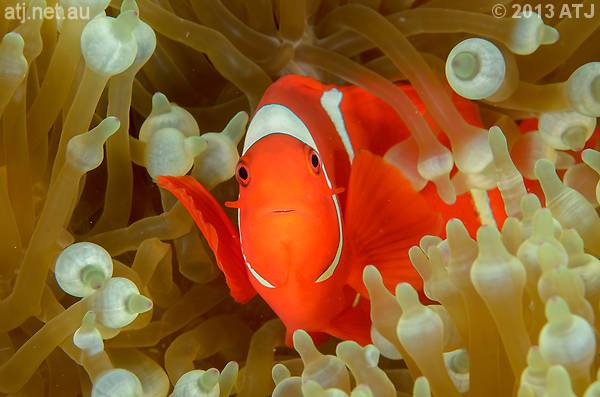
Spine-sheeked anemonefish, Premnas biaculeatus.
After lunch we sailed 18 kilometres north east for the last dive of the day (and the last dive in the south). We were given a choice between a site called No Contest which had a lot of large fish or Love Potion which was good for marco. Naturally, I chose Love Potion, and I'm glad I did as it was a great dive. I found a regular pygmy seahorse and Ongko found 3 yellow forms which I had never seen before. Dive details
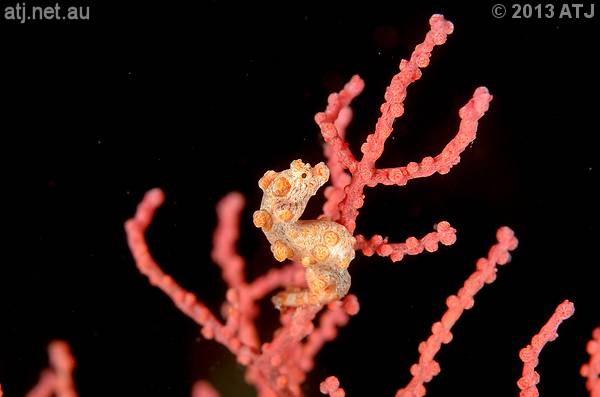
Yellow pygmy seahorse, Hippocampus bargibanti.
After the dive at Love Potion (or No Contest) we took a side trip in the dinghies to a lagoon in amongst these very tall rocks covered in various plants, including orchids. We drank Bintang and frolicked in kayaks.
Video I shot for the lagoon trip which was edited by Larry Schaudies.
At around 5:30pm we started our very long sail north. We had nearly 180 kilometres to travel and it would take us over 14 hours.
We arrived off Mansuar Island at around 8am on Day 7 and shortly after went for a dive at West Mansuar. This was a nice easy drift dive along a reef slope. We were now in an area where Pontoh's pygmy seahorses could be found and it wasn't long before Nicole showed us two, one Ongko had found and one she found herself. Unlike the other two species of pygmy seahorse, Pontoh's pygmy seahorse is not found in sea fans which greatly increases the possible locations for finding them (more places to look) but if you happen to look in the right area might actually be easier to differentiate from the background. In addition to the pygmy seahorses, we saw a number of nudibranchs, flatworms and couple of pipefish. Dive details
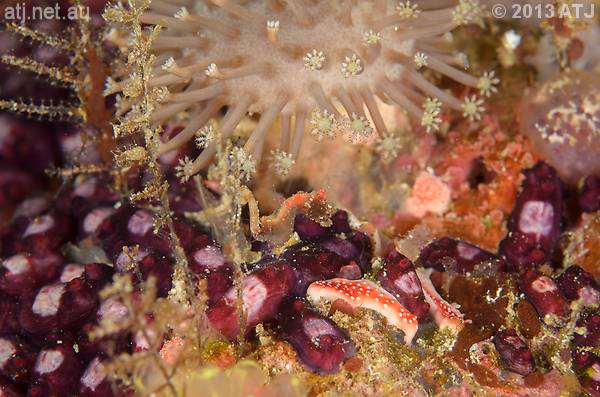
Pontoh's pygmy seahorse, Hippocampus pontohi.
The next two dives of the day were at a location called Manta Sandy. This was a sandy slope and flat with a number of bommies which served as cleaning stations for manta rays. On the first dive set up behind a line marked with coral rubble with a good view of the bommies. We were rewarded with a many reef mantas that came in to be cleaned, sometime 3 or more at a time. We were even buzzed by an almost all black manta that swam low right over us. Dive details
There were only a couple of mantas on the second dive and we quickly got bored waiting for them to show up. We found ways to amuse ourselves so we weren't bored for long. After we gave up waiting, Ongko took me along to one of the bommies where he pointed out a Pontoh's pygmy seahorse. I then swam all the way around the bommie and managed to find one myself. When I pointed it out to Ongko he indicated that there were actually two there together. Dive details
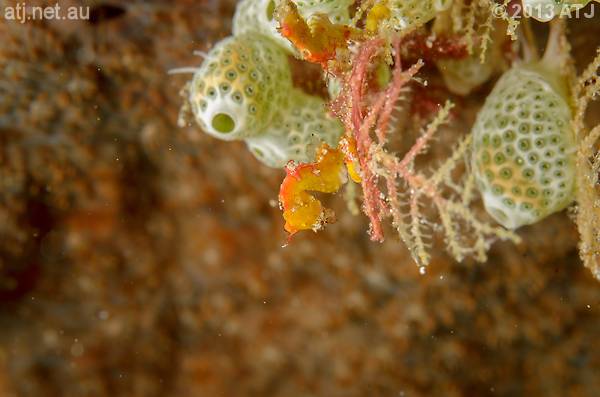
Two Pontoh's pygmy seahorses, Hippocampus pontohi.
We had a night dive planned at Arborek Pier but a storm came up and we had to move to a protected bay to wait out the storm.
Our early morning dive was at Karang Lalos. This was another submerged seamount and we followed it from one end to another getting progressively shallower. On the dive we encountered a tasselled wobbegong, a big school of bumphead parrotfish and a number of plakobranchs as well as the usual suspects of anemonefish, batfish, etc. Dive details
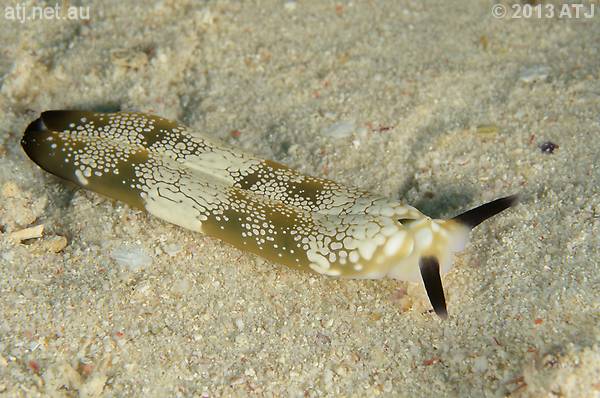
Sea slug, Plakobranchus ocellatus.
The late morning dive was at a site called Mayhem. There were lots of large schools of fish at this site, hence the name. We saw a couple of white tip sharks swim past. Dive details

Commensal shrimp, Ancylomenes tosaensis.
The afternoon was at a site called Citrus Ridge after the pastel shades of soft corals found on the reef. The highlight of this dive was the pairs of twin-spot gobies displaying to each other in a sort of dance. Dive details
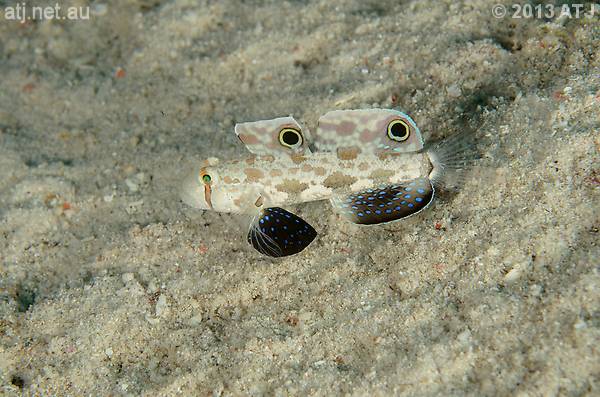
Twin-spot goby, Signigobius biocellatus.
The night dive at Arborek Pier was yet another fabulous dive. I was very pleased to find an ornate ghost pipefish and an egg cowrie. There was so much else to see, I didn't want to leave but Nicole made me. Dive details
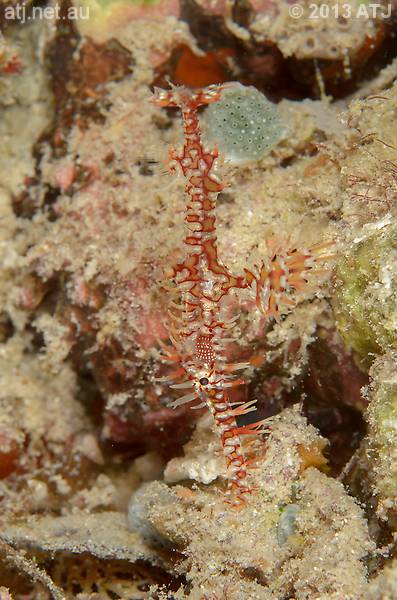
Ornate ghost pipefish, Solenostomus paradoxus.
Our first dive of the day was at Chicken Reef, so named because of the large pelagics which can make people too chicken to dive there. We saw grey and white-tip reef sharks, barracuda and mackeral as well as lots of small things, including Pontoh's pygmy seahorses. Dive details

Nudibranch, Chromodoris willani.
Dive #2 was at Cape Kri. This was a reef slope off the point of an island in Dampier Strait. It was full of life and we saw many interesting animals with the highlight being the warty anglerfish at the end of the dive. Dive details
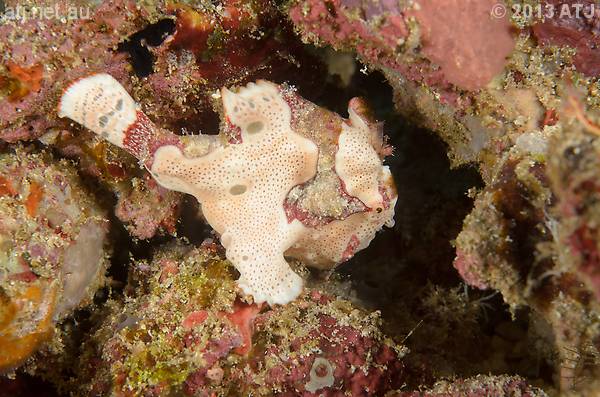
Warty angler, Antennarius maculatus.
The third dive of the day was at Blue Magic. This was a submerged sea mount and it felt like we were just jumping into deep water. The current along the way was quite strong which made it difficult to stop to take photographs. I also went through my air a little faster than I would normally. Near the end of the dive we saw a huge moray eel. I'm still kicking myself that I didn't take some video to show just how huge it was. As I started my ascent at the end of the dive I was lucky enough to briefly see a giant manta that had a wing span of at least 4 metres. It was a humbling experience. Dive details
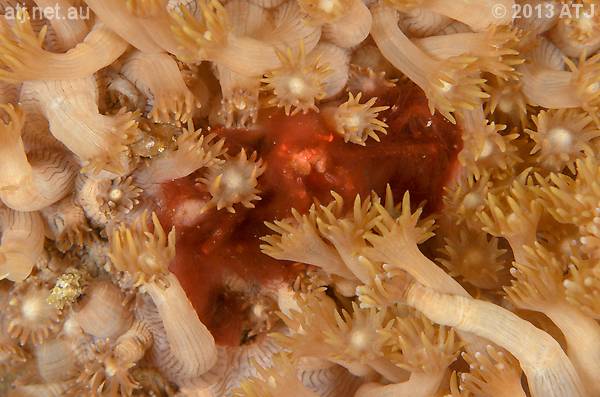
Orangutan crab, Achaeus japonicus.
After the dive at Blue Magic, the crew put the sails up and we were given the opportunity to take photos of the boat in full sail. Note that the sails a mostly for show and while they work, they probably couldn't stand a really strong wind. It's all in good fun.
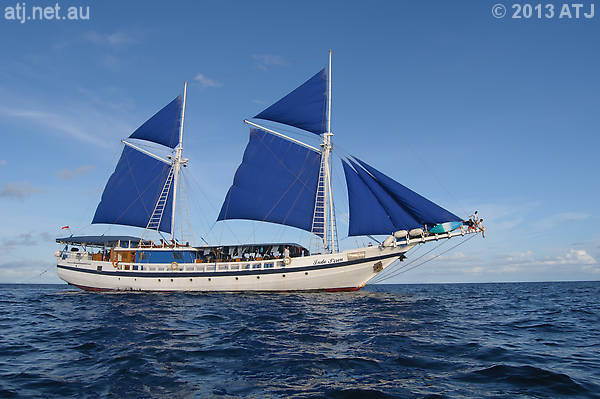
Indo Siren in full sail.
We also took our group photos of the guests and crew as the sun was setting.
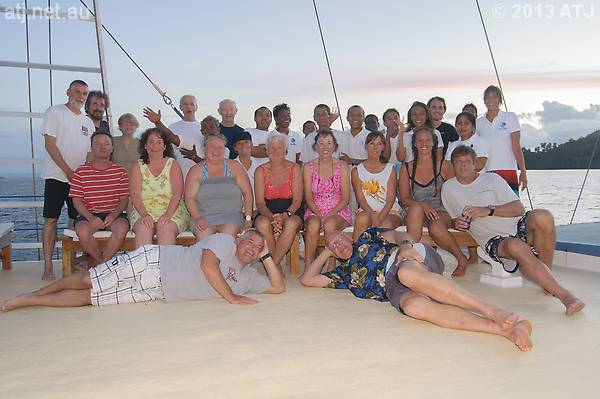
Guests and Crew on the sun deck.
Our last night dive of the trip was at Yembeser Jetty and what a fantastic dive it was. We saw bob-tail squid, crocodile fish, a banded frogfish, a striped mantis shrimp, a banded bamboo sharl but for me the best part was finding a blue-ringed octopus. I enjoyed the dive so much I didn't want it to end. Dive details
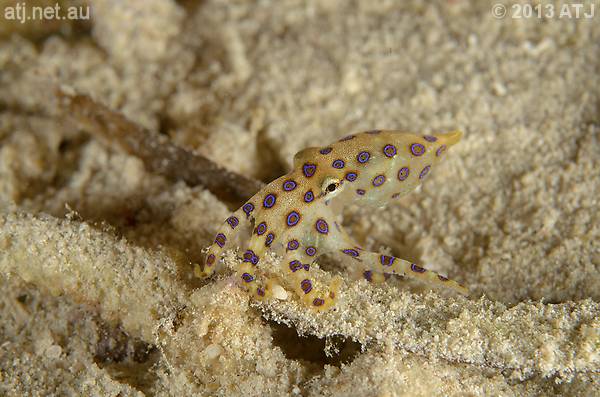
Blue-ringed octopus, Hapalichlaena lunulata.
Our second last dive of the trip was at a site called Mioskon. I have no idea of the origin of the name. It was a sea mount and we drifted around with the current. We saw a couple of tasselled wobbegongs, lots of polyclad flatworms, some Pontoh's pygmy seahorses and probably the smallest spinecheek anemonefish I have ever seen. Dive details

Tiny spinecheek anemonefish, Premnas biaculeatus, in a red bubble-tip anemone, Entacmaea quadricolor.
For out last dive of the trip we revisited Cape Kri. I really enjoyed the first time we dived here and was looking forward to this dive. Unfortunately, for some reason my mask fogged up and I had a lot of problems seeing through the viewfinder of the camera. It was a real pity as we saw a lot of cool critters, including a robust ghost pipefish, a yellow H. bargibanti and a Pontoh's pygmy seahorse. I managed to get photographs but not as good as I would have liked. Dive details
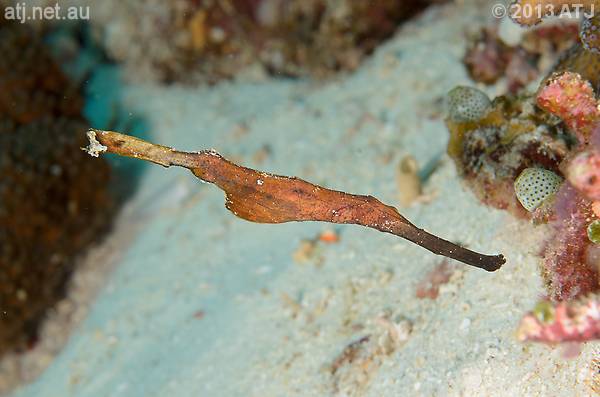
Robust ghost pipefish, Solenostomus cyanopterus.
That was the end of the diving and all that was left to do was to start washing and packing our gear while sailing back to Sorong. The actual trip back to Sorong was quite memorable because we were hit by a huge storm, with lots of wind and rain. Eventually the storm passed and we made it into Sorong Harbour at around 6pm. We then had a barbecue dinner and stayed our last night on the boat.
The last morning was when we all left the boat to make our way to our respective homes. Different people were on different flights out of Sorong so there were multiple departures throughout the morning. We were the last to leave and eventually it was our turn to say good-bye to the crew and the boat.
This was a thoroughly enjoyable trip. The diving was sensational. The crew, boat, food, accommodation were all fantastic. Even the guests were pretty good most of the time. ;). This is a trip I want to do again.
Last updated: 4 December 2013